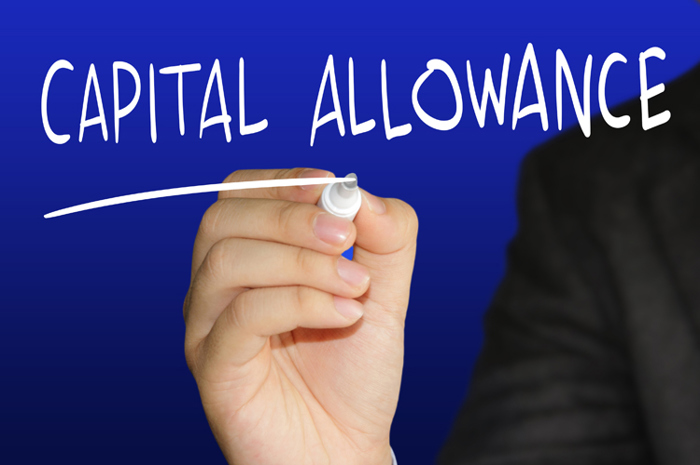Research and development (R&D) tax credits are a government incentive designed to reward UK companies
for investing in innovation. Also referred to as Enhanced Expenditure they are a
valuable source to reduce CT liability or to receive cash from HMRC
if a loss was made. The idea behind R&D is to incentivise companies to invest in
accelerating their R&D efforts, hiring new staff and ultimately growth.
To qualify for R&D Tax credits a company must be:
- Be a UK limited company that is subject to Corporation Tax.
- Have carried out qualifying research and development activities.
- Have spent money on these projects using either internal PAYE resources or a Third party.
What is classed as Research and Development
Not all projects are eligible as R&D is aimed at projects that are seeking to advance science or technology. The key requirements are:
- Be seeking an advance in the field of technology or science
- Be considered commercially innovative
- Incorporate science or technology that is not readily available in your industry
- Relate to your company’s trade – you must be intending to use the findings for your business
- Additionally, your company must not currently be receiving state aid or subsidised expenditure.
What can be claimed and how much Tax credit can you claim?
Currently any cost that is eligible for R&D Tax credit must be related to a 'R&D phase' of the projects life cycle - this could be PAYE costs of resources working on the R&D, equipment directly related to the research and any related third party costs.
The current rate of tax credit available is 86% this was reduced from 130% pre April 2023, of the R&D expenditure, therefore since you will also include the cost in the overall operating expenses, the overall impact will be 186 % (or 230% pre April 2023) increase in costs and hence a reduction in corporation tax liability.
In companies which are yet to be cash generative (potentially in start-up phase) or loss making you may be entitled to a R&D tax credit payment from HMRC. The exact amount of R&D relief that you can receive and the actual amount you can claim back as a Tax Credit is related to many factors, you can use our Research and Development Calculator to assess the impact of R&D relief.
For financial period starting after 1st April 2021, HMRC have introduced a cap on the amount of R&D tax credit that can be claimed. This is following on from the introduction of the CT600L from the start of April 2021 for all R&D tax credit claims. The cap is now the lesser of the existing calculation - the surrendable loss X 10% (14.5% PRE April 2023) or 3 times the total PAYE paid by the company to HMRC + £20,000. This means that if you have not been registered for PAYE or only spent R&D on contractors, then your tax credit will be limited to a maximum of £20,000.
If you have an accounting period that straddles April 2023 (part of the year falls before this date and part afterward) then the R&D claim is calculated by pro-rataing the spend over the period. This is all calculated for you, within our software.
How do you claim?
Although the process may seem complex to the inexperienced; it's actually relatively straight forward, with many people in Micro & Small business sizes put off by not knowing what can be claimed and how to file the Digital Filing return to HMRC. The Easy Digital Filing CT600 template has sections specifically for R&D. The following steps guide you through the process from start to finish.
Step 1 - Identify R&D work/Projects that you are undertaking
Clearly the type of company you are and what your activities relate to will dictate if you are able to take advantage of R&D. However, although the headline are companies in the tech or scientific space, many other industries also carry out R&D. For example companies which rely on Information Technology may perform research to build a system which will be a game changer and advance their capabilities.
Once you have identified a project or package of work that looks like R&D look at the 'problem' or challenge and perform the following tests:
- Will the work perform a technical advance - will the solution provide new technological functionality for you
- Are there technical uncertainties in the work - are you going into the work with 'unknowns'
- Will you be able to describe how the uncertainties are overcome
- Can you explain why the uncertainties could not just be resolved by a competent professional
We would recommend that you use the headings above in your R&D report - this is the supporting document which you attach as part of your R&D submission when Filing. In our experience most companies create a report of around 4-6 pages detailing the project and the rationale against each of these tests. Note that this report needs to be converted into the pdf format.
Step 2 - Keep a note of all costs and time spent on R&D
You may be fortunate and have a ring fenced R&D team, however, it's likely that you will have fungible resources that work on other (non-R&D) activities. You may also have multiple R&D Projects which will require a separate R&D report for each.
If you have a time booking system you can use that so that people allot hours. Otherwise you may need to work out a proportion of time using your justifiable discretion.
Step 3 - Make a CT600 return include R&D amounts & attach the R&D report(s)
When your accounting year has completed and you are ready to file, create and open your CT600 Filing and select the section "Research & Development(R&D) / Creative Enhanced Expenditure". When you select yes the supplementary section will be visible in the section navigator.
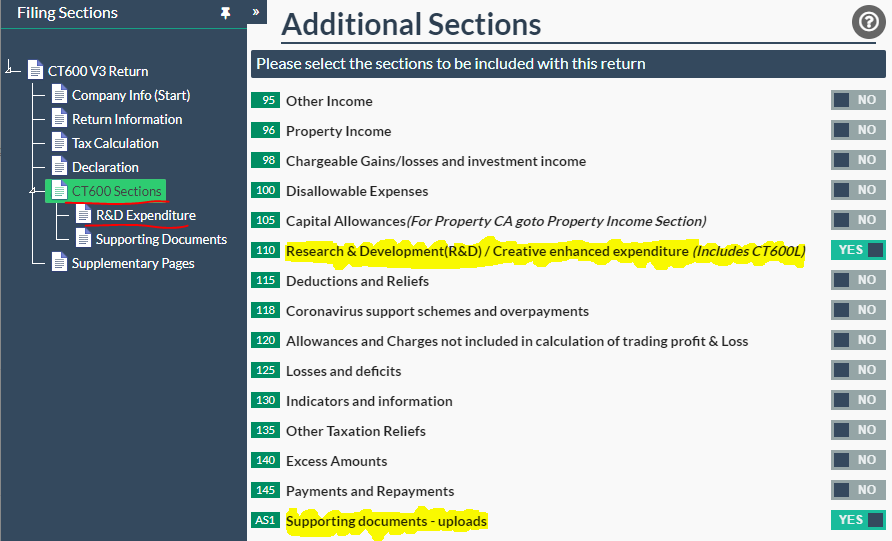
Add the total spent on R&D into box 166
From this figure easydigitalfiling software will calculate the amount of enhancement due.
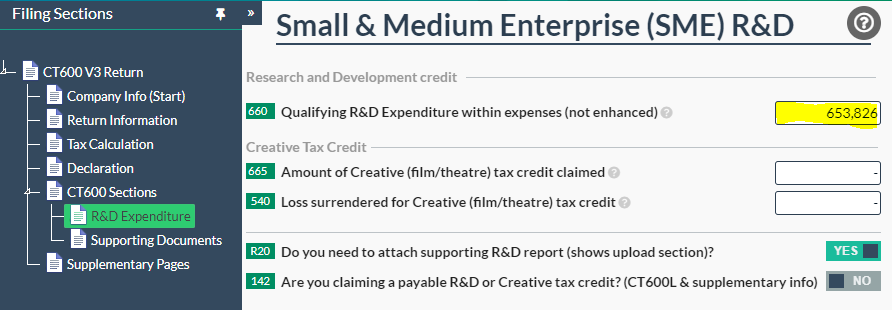
If you are claiming a tax credit, switch box 142 to yes, this will reveal the fields required for the CT600L.
If your R&D expenditure will only result in a reduction in your corporation tax liability, you do not need to switch on box 142 as CT600L is not required.
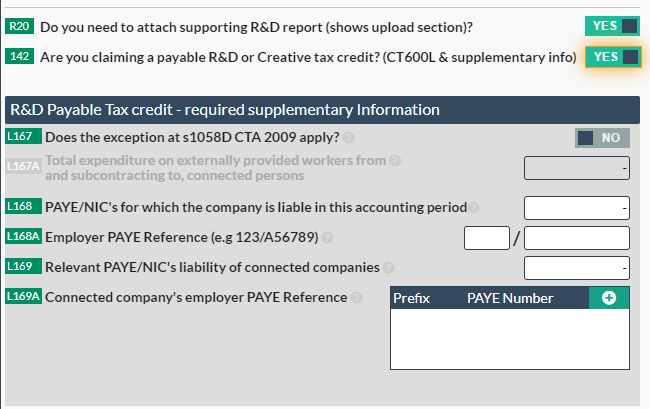
If the s1058D CTA CTA 2009 exemption applies, please click box L167 to yes and complete L167A.
If you make PAYE payments, complete box L168 and L168A (also boxes L69 and 169A if applicable), easy digital filing will calcualte the amount of tax credit payable.
You will only need to complete this section if your return period starts on or after 1st April 2021. You will need to click box 142 to yes for all R&D tax credit claims.*
*at the moment HMRC's interface is awaiting an update and these fields will be required for all returns.
Click on the payments and repayments page to see the amount calculated. Complete the bank details of the account where you would like the tax credit paid into.
Attach your R&D supporting documentary evidence.
Since August 2023 there are additional documentary requirements HMRC require to be completed before submitting an R&D claim.
However if you have any additional information to include you can upload within our software: in the CT600 sections add "Supporting Documents" and attach/upload the file.
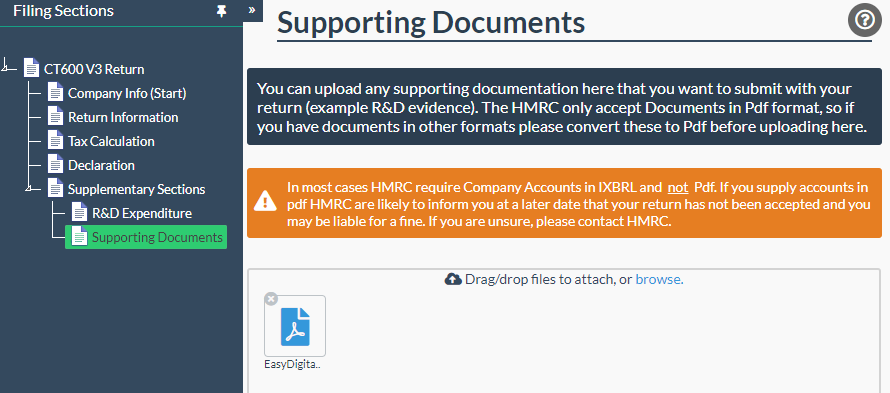
Review your R&D costs against your other return inputs
In our example below the company had £2,500,000 of income, with £1,200,000 of expenses (which already include all costs including R&D ). The R&D element also been added as above to R&D resulting in a R&D credit of £849,973 (pre April 2023).
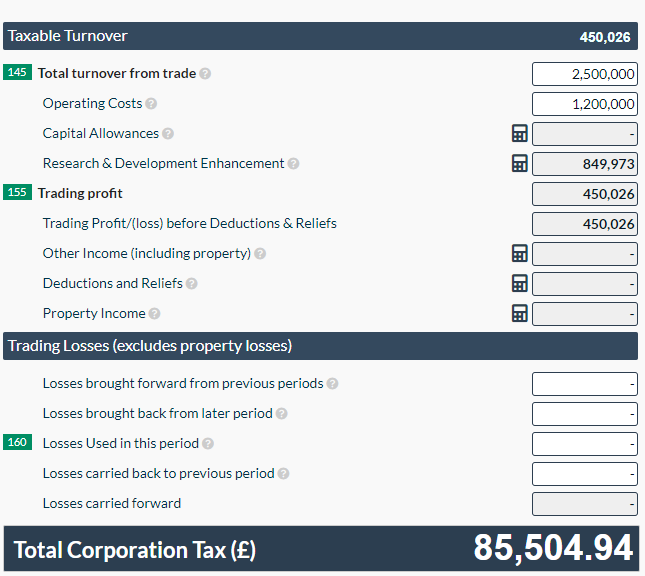
This has reduced the CT liability by the 130% fo the R+D costs - £849,973 (653,826 * 1.3) and now resulted in total CT to pay of £85,504.94. If we had not claimed R&D then our Taxable Turnover would have been £1,300,000 (2,500,000 - 1,200,000) and at 19% CT that's a whopping £247,000 so claiming for R&D has saved £161,495.06
Payable Tax Credits
If you choose not to opt for a R&D tax credit, then you can carry the total loss, including the enhanced loss generated by R&D calculation forward to your next period to off-set against future profits. Find out more about moving losses from period to period.
You can use our R&D Online Calculator to find out how R&D Tax relief can reduce your CT liability, potentially pay you a tax Credit if you are Loss making and help your business's cash position.





